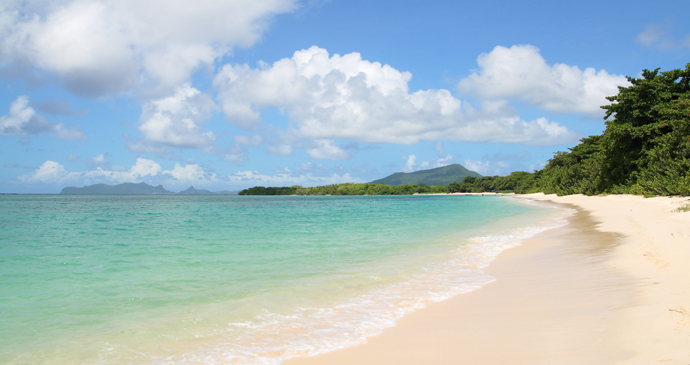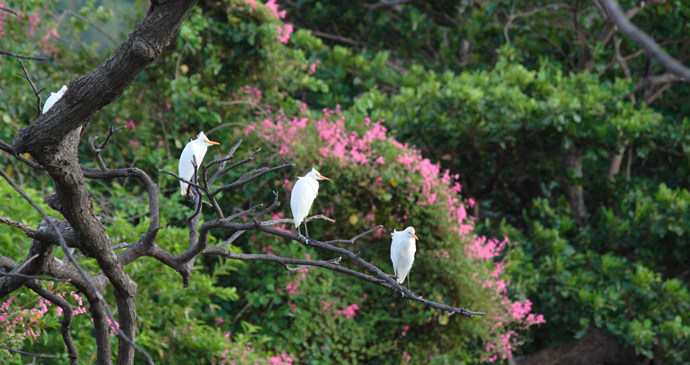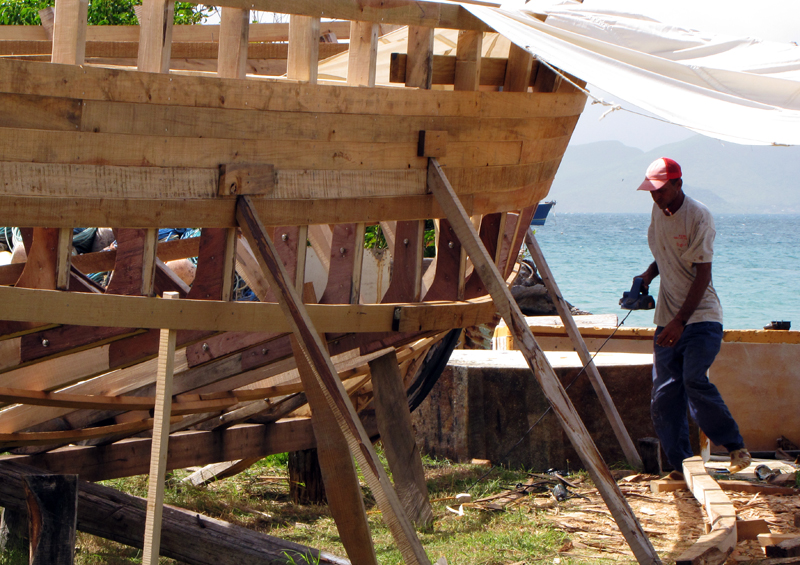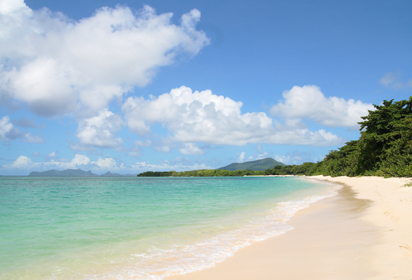Written by Paul Crask
The children of the village accompany me for a while, asking where I am from and why I am walking. I tell them that if I had not been walking I wouldn’t have been lucky enough to meet them and their beaming smiles outshine the sun.
The first time I went to Carriacou, I found myself doing a lot of walking. Combined with hitching rides and taking local buses, it is absolutely the best way to explore this enchanting island of castaways, boat builders, big drummers and some of the most idyllic stretches of sand in the Caribbean.
Carriacou and its diminutive sister, Petite Martinique, are located in the Southern Grenadines and belong to the tri-island nation of Grenada. You can get there by light aircraft from Maurice Bishop International Airport, but actually I think it’s much more fun to hop on board the Osprey Ferry which departs daily from the Carenage in Grenada’s capital, St George’s. The journey takes about 90 minutes and passes along the pretty west coast of Grenada. It’s a great way to meet Kayaks, the name given to the people of Carriacou who, more often than not, will be buried beneath overflowing bags of supplies they have purchased from stores on the main island.
The ferry arrives at Hillsborough, Carriacou’s principle town. Fringed by a narrow beach and located on a beautiful bay, Hillsborough has just one main street which is lined with a hotchpotch of stores selling clothing, food and delicacies, a number of simple eateries and a smattering of small market stalls. The Carriacou Museum, housed in a former 19th century cotton ginnery, has a fine collection of Amerindian artifacts that are regularly unearthed along the island’s ever-eroding windward coastline of Sabazan.
Anse La Roche is Carriacou’s big secret – the beach those in the know whisper and nod their heads about to each other when they hear tourists heaping praise upon Paradise beach in the south.
I decide to head along the beach towards L’Esterre Bay. It used to be possible to walk and drive right across the Lauriston Airstrip to get to Carriacou’s south western coast, but now, if you are driving, you have to take a rather wayward inland route to get there. On foot, it is much more fun. At Lauriston Point, where the beach and road come to an end, a narrow footpath appears in the coastal mangrove. Meandering this way and that, ducking beneath low branches and occasionally emerging at a shoreline of shallow oyster beds, I finally arrive at Paradise Beach.

Serene and idyllic, Paradise Beach has to be one of the Caribbean’s finest. I enjoy a drink at the Hardwood Bar & Snackette. The bar has a water taxi that can take you to the outlying Sandy and Mabouya islands, where shallow inshore reefs make for great snorkeling. Aside from a cook, a waitress and a couple of gulls that are perched on the bow of a lonely rowing boat, I seem to have this beautiful place all to myself. Sunlight sparkles off the clear, calm waters, where not even a ripple seems to disturb the serenity.
Before heading off towards Harvey Vale and Tyrell Bay, I buy an attractive hand-made t-shirt from Fidel Productions and wander through the sleepy village of L’Esterre where, it is said, people still converse in French Patois. But sadly there is no-one around, just the enticing aroma of freshly baked bread from Henrietta’s Bakery to keep me company along the road. The expansive Tyrell Bay is a natural anchorage and home to the Carriacou Yacht Club. Its sheltered waters are crowded with an assortment of vessels, from expensive-looking yachts to rather sorry-looking old wooden schooners.
The bay front at Harvey Vale is crammed with bars and eateries, most offering a good selection of local lunches, including a bewildering variety of lambi, or queen conch, dishes. I resist a few beckoning waves and instead continue my trek, wandering around to Hermitage, a quaint settlement of squat stone houses that nestles on the southern tip of the bay, and where long-bearded castaways seem to be fixing up the shipwrecks in which they were once marooned. At the Lazy Turtle restaurant I grab a cold beer and a bite of pizza, probably the best there is in this little corner of world’s end.
Home to the world famous Carriacou sloops, Windward has a tradition of boat building that goes back to the days of the first settlers from Scotland, whose ancestors still live in the village today, and whose maritime skills have been passed down through the generations.
The next day I decide to walk north from Hillsborough. I pass through the villages of Craigston and Bogles (where Roxanne and Phil run the very unique Bogles Round House Restaurant) and arrive at the beginning of the High North Nature Trail, a coastal woodland path that skirts the High North National Park. The trail, like the rest of Carriacou, is supremely peaceful and I enjoy the tranquility of its woodland scenery and the lofty views down to the western coastline. At a paint splash on a large boulder I take a detour, heading downhill through rough scrubland and rocks to emerge at Anse La Roche, a very attractive beach and bay.

Here the sea is rolling in with a purpose, crashing down hard onto the untouched white sand beach. Anse La Roche is Carriacou’s big secret – the beach those in the know whisper and nod their heads about to each other when they hear tourists heaping praise upon Paradise beach in the south. But for me, Carriacou’s finest stretch of white sand only reveals itself after a further walk through yet another coastal mangrove forest, this time in the far north at L’Appelle, beyond the bluff of Gun Point.
The long, narrow beach at Petit Carenage Bay is absolutely breathtaking. Turquoise waves dance in all directions in confusing currents. Across the water is Petite Martinique and, to the east, stranded on a shallow reef, is the rather melancholy hull of a grounded ship that is just begging to have its picture taken or its portrait painted.
But for me, Carriacou’s finest stretch of white sand only reveals itself after a further walk through yet another coastal mangrove forest, this time in the far north at L’Appelle, beyond the bluff of Gun Point.
Rounding the top end, the trail turns into a narrow road and I enter the village of Windward. Home to the world famous Carriacou sloops, Windward has a tradition of boat building that goes back to the days of the first settlers from Scotland, whose ancestors still live in the village today, and whose maritime skills have been passed down through the generations. Along the water’s edge, skeletons of hulls take shape and stand facing down the seas they will one day try to master.

Windward boat launchings draw people from across the island to this quiet corner where fiddlers and guitar players sing sea shanties, women cook traditional oil-down and cou-cou in large iron pots over open fires, and men flex their muscles in preparation for the final heave-ho. Together with village Maroon Festivals and Big Drum dancing, both vivid evocations of an African legacy, boat building is a quintessential part of Carriacou’s cultural heritage.
I climb out of Windward, up the sloping hillside of Limlair, a landscape of pigeon peas and black sage scrublands. At Belair, stone windmill towers are another reminder of the island’s past, where estates would harness wind power to drive sugar cane and lime crushers. Children wave at me as I reach the brow of the hill and begin my descent back down to Hillsborough Bay. They accompany me for a while, asking where I am from and why I am walking. I tell them that if I had not been walking I wouldn’t have been lucky enough to meet them and their beaming smiles outshine the sun. Arriving in Hillsborough, I sit on the jetty and wait for the ferry to arrive. Experiencing Carriacou has been like taking a welcome time-out, and I am very reluctant to leave.
Originally published in Caribbean Beat Magazine
Learn more about Carriacou in our new Grenada guide:

